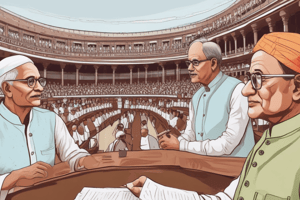Podcast
Questions and Answers
How many senators are there in the United States Senate?
How many senators are there in the United States Senate?
- 200
- 50
- 435
- 100 (correct)
What is the primary purpose of the system of checks and balances in the United States?
What is the primary purpose of the system of checks and balances in the United States?
- To eliminate the judicial branch
- To ensure a separation of powers among branches of government (correct)
- To concentrate power in the executive branch
- To abolish the legislative branch
Which chamber of the Union Parliament has 435 voting members?
Which chamber of the Union Parliament has 435 voting members?
- House of Representatives (correct)
- Supreme Court
- Senate
- Congress
How often are members of the Senate elected?
How often are members of the Senate elected?
Which branch of government is responsible for making federal laws in the United States?
Which branch of government is responsible for making federal laws in the United States?
What additional powers does the Senate have beyond making laws?
What additional powers does the Senate have beyond making laws?
What is the primary role of the Senate in the American government structure?
What is the primary role of the Senate in the American government structure?
Why is civic engagement with the Union Parliament considered essential?
Why is civic engagement with the Union Parliament considered essential?
What do committees and subcommittees in the House and Senate primarily focus on?
What do committees and subcommittees in the House and Senate primarily focus on?
How can individuals engage with the Union Parliament to participate in the democratic process?
How can individuals engage with the Union Parliament to participate in the democratic process?
Which aspect of the American government structure is designed to prevent the abuse of authority by any branch of government?
Which aspect of the American government structure is designed to prevent the abuse of authority by any branch of government?
Why is it important for individuals to contact their representatives in the Union Parliament?
Why is it important for individuals to contact their representatives in the Union Parliament?
Flashcards are hidden until you start studying
Study Notes
Government Structure and the Union Parliament
The United States is a federal republic with a system of checks and balances that ensures a separation of powers among the legislative, executive, and judicial branches of government. The federal system benefits from a strong state and local government presence, which facilitates responsiveness to the needs of diverse communities.
At the federal level, the Union Parliament consists of two chambers: the Senate and the House of Representatives. The Senate is composed of 100 senators, with each state having two senators. Senators serve six-year terms, with one-third elected every two years. The House of Representatives is made up of 435 voting members, with the number of representatives per state determined by population. Members of the House serve two-year terms.
The Senate and House of Representatives are responsible for making federal laws. Usually, a bill must pass both chambers with the same version before going to the president for approval. The Senate has additional powers, such as ratifying treaties, confirming presidential nominations, and holding impeachment trials.
Key Considerations for Government Structure
- Separation of Powers: A division of power among the legislative, executive, and judicial branches helps maintain a balance of authority and limits the concentration of power.
- Representation: Both the Senate and the House of Representatives are designed to represent the interests of the American people, with the House reflecting population distribution and the Senate providing equal representation to all states.
- Checks and Balances: The constitutional framework for the balance of powers is designed to prevent the abuse of authority by any branch of government.
- Decentralized Governance: The federal system allows for a strong state and local government presence, promoting responsiveness to the needs of diverse communities.
Union Parliament in Action
The Union Parliament plays a crucial role in the legislative process, debating and voting on bills, approving budgets, and conducting oversight of the executive branch. The House and Senate have committees and subcommittees that focus on specific areas of policy, allowing members to gain expertise and work to pass legislation that addresses the needs of the American people.
Engaging with the Union Parliament
Civic engagement with the Union Parliament is essential for maintaining a healthy democracy. One way to engage is by tracking the work of elected representatives, staying informed about the legislative process, and attending local events and meetings. It's also important to contact representatives to share concerns, ideas, and feedback.
To learn more about government structure and the Union Parliament, consider participating in local civic organizations, attending informative events, and exploring educational resources. By deepening your understanding of the government structure and the roles of the Union Parliament, you can become a more informed and engaged citizen, able to participate in the democratic process and create change within your community.
Studying That Suits You
Use AI to generate personalized quizzes and flashcards to suit your learning preferences.




